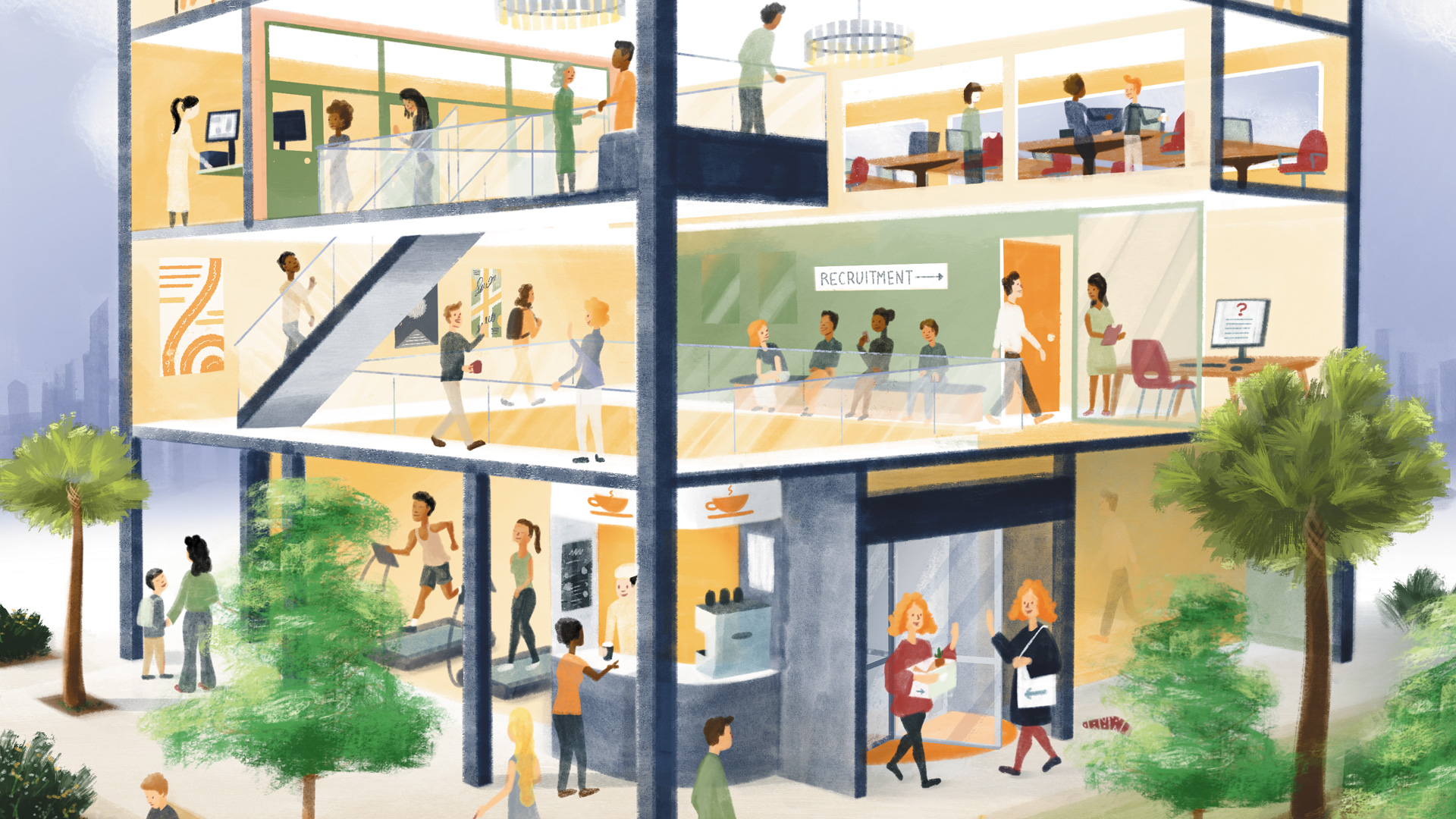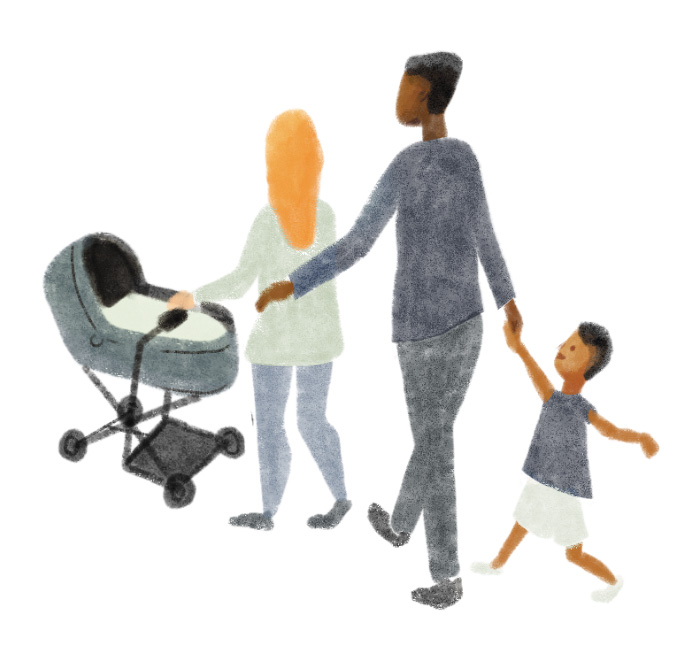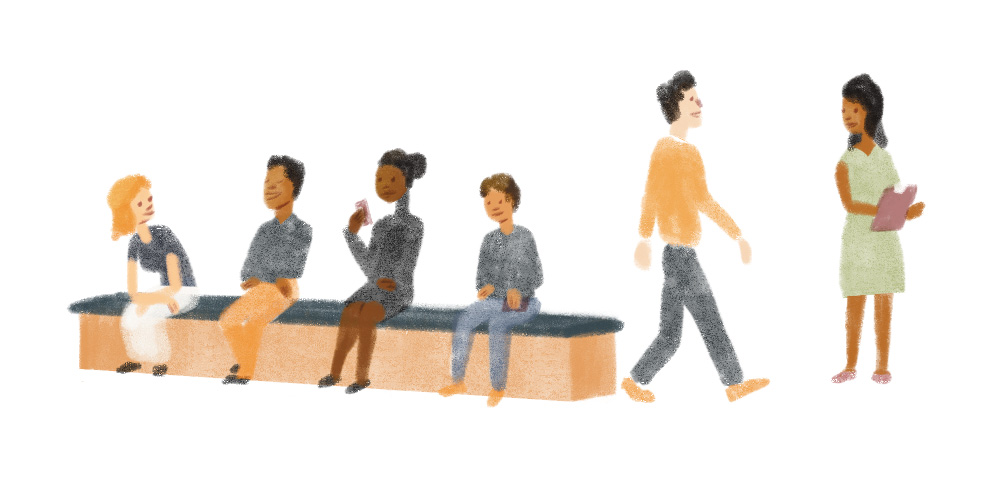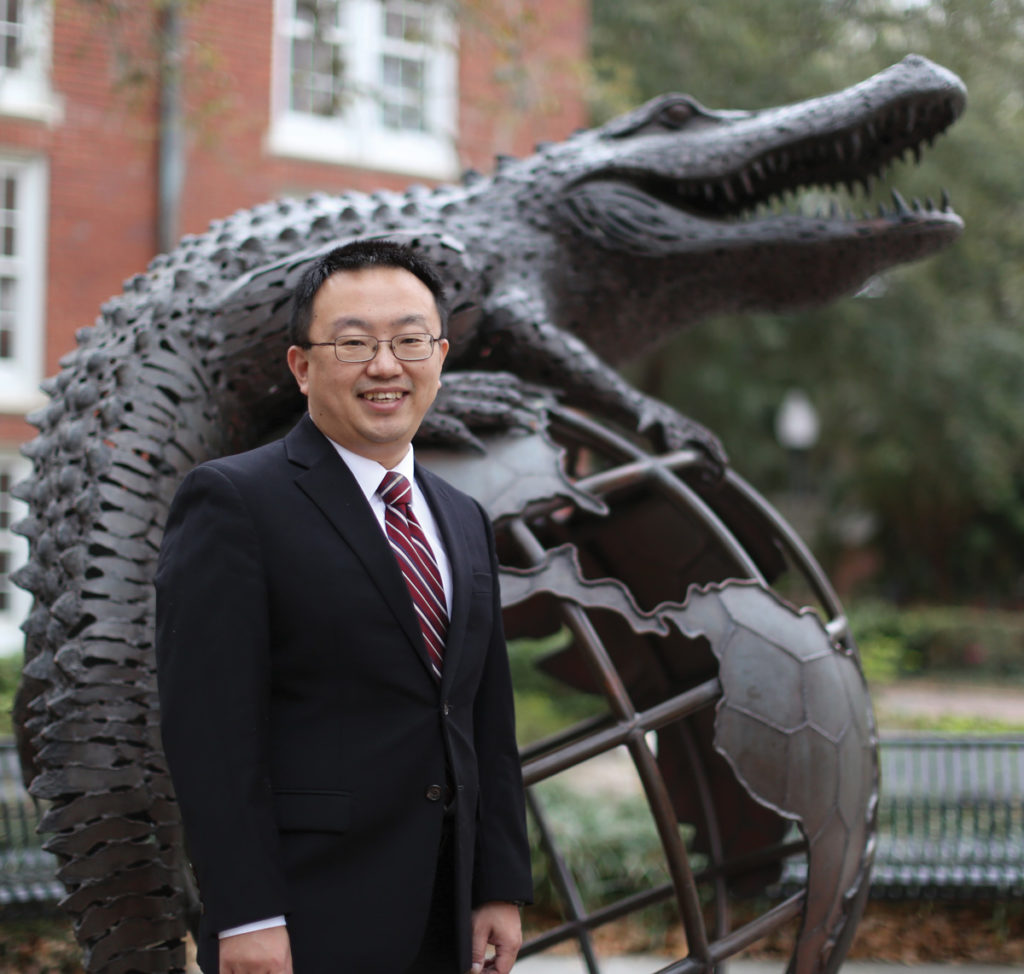Where, when and how we work may never return to pre-pandemic norms. Artificial intelligence and demographic shifts will reshape our careers. And we’ll need to tend to ourselves and each other to ward off burnout and grow as workers and leaders. That’s what we heard when we asked for advice and predictions from University of Florida management faculty — the country’s top management department in publications per capita in a 2021 Texas A&M/University of Georgia research productivity ranking.
The faculty’s shift toward envisioning the long-term impact of pandemic-era disruptions is a natural extension of their research, says Warrington College of Business Dean Saby Mitra, who calls their work “very applicable to people’s daily lives.”
Jump ahead to a section:
- Autonomy and flexibility
- Boost performance with self-compassion
- Navigating AI and hiring
- Burnout and recovery
- Age diversity on the job
- Future-proof your skill set
- Retirement planning beyond money
Hello again: Coming back to a job you quit
If you left your company in the Great Resignation and you’re wishing you could undo your decision, maybe you can, says Brian Swider, one of a handful of experts worldwide studying “boomerang employees” who leave and return to the same company.
What boomerang employees should emphasize
Before you approach your old organization, think about how you’ve changed since you left. What relevant experience did you gain?
“External hires will have a similar pitch about their knowledge, skills and abilities, but the boomerang employee can say, ‘Here’s how I would apply it,’” he says.
Highlight how you can hit the ground running: Returning employees can save their employer up to 66% in onboarding costs due to the lower amount of training required and their ability to reach full productivity faster, Swider says.
Why employers should consider boomerangs
When Swider brings up returning employees in his executive classes, one concern always emerges: “They think hiring back an old employee would tell other employees they can leave without consequence.”
He hasn’t seen any evidence to support increased turnover, however. In fact, hiring boomerangs can boost job attitudes for the returning employee and their co-workers, he says. When proven performers want to return, bear in mind that you know more about their skills and how they fit into the culture than any external candidate. Along with the streamlined onboarding and a quicker path to full productivity, boomerang candidates can also create a larger applicant pool, which increases the likelihood of a successful hire, Swider says.
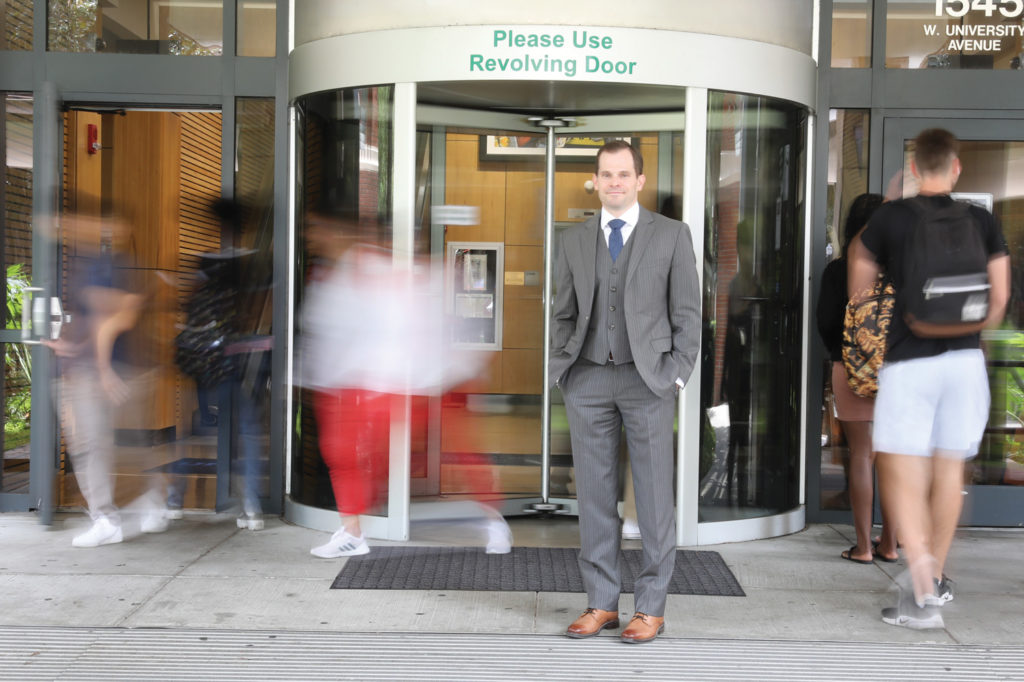
That said, not all boomerangs are worth rehiring. Swider’s 2017 study in the Journal of Applied Psychology showed that top performers and employees with shorter time outside of the company were more likely to be successful upon return.
“Put your pride aside,” he says. “If you have a dossier of people who you know are great performers and you’re willfully choosing not to reach out to them, that seems like a suboptimal decision.”
What to do when parting ways
Resigning gracefully makes an eventual return less awkward, but employers should smoothe the separation as well.
“Companies are starting to focus on the offboarding process as much as onboarding,” Swider says.
What workers say in exit interviews can be useful later to woo back top performers. Some companies recruit boomerangs proactively, creating alumni groups on LinkedIn and having mixers for former employees.
“You can reach out to that person to see, was the job you left for really all that you expected? Are there things that we could do or things we have changed that address the concerns you expressed?” Swider says.
Returning to a former employer might seem awkward, but research indicates the opposite.
“What we find is that the returners typically are going to be more satisfied and have a better appreciation for the job. They also recognize that their organization cares about them. Those two factors make boomerang employment a worthwhile proposition for both parties.”
Workers will say, ‘You can’t have all of me’
As offices return to pre-pandemic routines, management researcher Joyce Bono expects to see lasting changes in workers’ expectations. After 42 hours of interviews with dual-career couples for a forthcoming study, she predicts that employees will want to keep the flexibility to toggle between family and work demands.
Q: When you asked dual-career parents how the pandemic changed their outlook on work and family, what did you find?
A: People — mostly mothers — have been complaining forever that they can’t get their kids off to school in the morning or pick them up after school. But now it’s fathers’ voices joining, saying, ‘Even if I have to go to the office every day, why do I have to be there at eight o’clock because somebody decides that’s my start time? Why can’t I work from six to eight in the morning, take my kids to school and then show up at the office?’ This is not just about people with children. We’re seeing the same thing with childless people or people whose kids have left the house saying, ‘my work can’t have all of me.’

Q: What changes are needed to make that work?
A: Trust. As a manager, you will need to have relationships with your employees that are trustworthy enough that when you don’t see them, you believe they’re working. You need a way to set some kind of parameters and communication so that when I’m working at home, you’re not pinging me with emails just to see if I’m responding. What that’s going to require of employers is to think more about results. If the results aren’t there, then rather than micromanage you, I train you. I mentor you. If the results still don’t happen, then this isn’t the best relationship.
Q: What will the challenges be?
A: Best Buy tried a results-only work environment where you could work from anywhere, and within the first few months, something like 30% of the people wanted to go back to the office. They needed the structure. They wanted separation between work and life. So that’s one thing we should acknowledge — it isn’t for everyone.
Q: What do employers stand to gain?
A: Historically, these issues have led women to drop to second-class careers. So they’re going to get all this female talent that they haven’t been able to get. They’re going to keep their best employees, because the people who can leave for another job are actually your very best ones. Your people are going to be happier and healthier. Will it make more money for you? No, but it also shouldn’t have to reduce your profits. If your corporation is trying to suck dry everything you can from every employee, if you think of them as a resource to be used up, this will not work for you.
Q: What about jobs that require work at a specific time and place?
A: ‘You can’t have all of me’ doesn’t mean I have to have balance every day. There are many ways to achieve balance. We could look at the notion of a sabbatical for people like nurses to be able to renew with a longer break from work.
Q: What can workers do to facilitate this change?
A: For all the speaking we do about family first, our society says our devotion to work comes higher. One of my executive MBA students was taking a vacation with her husband, and they couldn’t do a bike trip they wanted to do because there was no cell phone service and he had to be reachable by his company. That’s got to change, and it’s going to help if key valued employees start asserting it. When executive employees, especially men, say ‘I’m leaving today at three o’clock because my child’s in a play, and I’m going to work at home tomorrow’ — those first steps are valued.
Building your resilience with self-compassion
We asked researcher Klodiana Lanaj how showing kindness to yourself can make you a better worker. Here’s what she had to say.

Work has gotten more challenging during the last few years as we have dealt with the uncertainty of our jobs, health, and the future of the world. The silver lining in all this is that we are — to a certain degree — going through these hardships together as a society. These shared experiences enable us to understand and to empathize with those among us who are struggling to be productive or to remain hopeful. One piece of advice that emerges from my research is that we all need compassion to navigate the challenges of daily life at work, and in particular, we all need self-compassion.
Self-compassion happens when we treat ourselves as we would treat a good friend who is going through a hard time. Often, we are harsher on ourselves than on our friends: Remember that time when you made a mistake at work and beat yourself up about it for days on end? Chances are that if a close friend made a similar mistake, you would empathize and encourage them gently to move on and to learn from the situation rather than dwell on it. We all deserve this same treatment when we make mistakes or face hardships.
In some of our research, my colleagues and I find that when employees take a few moments of their day to think about work challenges with a mindset of self-compassion, they feel more energized, more optimistic about their capabilities at work, consequently performing better, and feeling more resilient. We find similar effects among leaders — when they approach leadership challenges with a mindset of self-compassion, reminding themselves that their struggles are part of being a leader, they help others more at work, and are seen as more effective and kinder by their coworkers too.
Navigating AI and hiring
With artificial intelligence taking a larger role in screening job applicants, Mo Wang — whose research in equitable AI-assisted hiring is supported by a nearly $1 million grant from the National Science Foundation and Amazon — offers these tips.
Avatars are people too: For jobs with a large applicant pool, your first round of interviews might be with an avatar instead of a human. Job seekers should dress, act and answer as if the avatar or recorded interviewer were a live person, Wang says. Always assume a human will review the audio and video recording of the interview.
Get to know O*NET: Technology might sift through applicants’ resumes before they reach a human, so relying on your cover letter to wow a manager might not work. To help your resume make the cut, Wang suggests searching the U.S. Department of Labor’s O*Net website (onetonline.org). O*Net offers a ranked list of skills for more than 900 occupations to help prioritize keywords to include and experience to emphasize.
Never fully rely on AI: For employers, it’s important to know that while AI can speed the screening process, humans should review the hiring system’s decision-making to ensure fairness, Wang says. Organizations that unwittingly allow bias to seep in from flawed technology may miss out on top talent and face legal consequences down the road.
What science tells us about beating burnout
You might think being constantly connected to work helps you stay ahead. You’re wrong, says researcher Brian Swider. Although it may feel productive to mind your inbox when you’re off the clock, separation actually makes you a better worker.
“The drawbacks to staying attached in terms of your stress, your cognitive functioning and your physiological wellbeing will offset any sort of benefits you think you’re going to get,” Swider says.
In an analysis of 25 studies of more than 6,000 employees, Swider identified burnout as a top predictor of turnover, accounting for about 11% of turnover and 13% of job performance. To fight burnout, make the most of the time you call your own by focusing on the components that research shows contribute to recovery. Three are relatively obvious: psychological detachment from work, relaxation, and control over how you spend your time. The fourth is less expected: mastery.
Mastery sounds taxing, but it doesn’t have to be, Swider says. You don’t have to perfect sourdough or learn an instrument to recover from work stress. Swider likes a streaming binge as much as the rest of us, but he likes to plan his movie lineup and contextualize what he watches as part of a deeper experience.
The activities that check those boxes will be different from person to person, but keeping those parameters in mind can help you find what works for you, Swider says — especially if you have difficulty separating from work during off hours.
“Taking a more effortful approach and being more planful about what you’re going to do can ensure that you are taking the steps to maximize the rejuvenative elements of recovery.”
Older workers will change work for all of us
By 2030, we’ll see 96.5% more workers 75 years and older, the U.S. Bureau of Labor Statistics predicts, with 8% more workers 55 to 74. By the end of the decade, nearly 10 percent of the civilian labor force will be older than 65.
Spurred by longer life spans, lack of savings and an aging of the population overall, “we’re going to see larger age diversity in the workforce,” says Mo Wang, whose research focuses on older workers. “People are very used to most of their peers at work being in the same age group, but, we’re going to see more and more mix of ages.”
Wang foresees a wave of retirees returning to the workforce amid inflation and a possible recession. To stay relevant, older workers will need to learn new skills faster than they might be accustomed to, which could result in some unusual mentoring arrangements, Wang says. Instead of more experienced employees mentoring younger colleagues, mentoring will flow both ways, he predicts.
“We’ll see peer mentoring between younger workers and older workers to leverage different kinds of knowledge, because both sides have good expertise. If you don’t have that, you might waste your technology advantage.”
For older job seekers, Wang recommends touting the social and emotional skills age brings, and reminding hiring managers that, as demographics shift nationwide, their customers may be aging too.
“Having older workers can help you understand their needs better,” he says.
Future-proof your skill set
Knowledge-based workers might not have to worry about being replaced by a machine in the short term, but “downsizing, layoffs, and automation are legitimate threats to employees’ livelihoods,” says management professor Brian Swider. So what can workers do? Swider and management department chair Mo Wang offer these suggestions.
Embrace virtual management
“Managing people is something we probably won’t let artificial intelligence take over — that will always be a human task,” Wang says. What will change is how we manage as teams become more distributed through remote work. Managers with a track record of supervising a hybrid or fully remote team efficiently will have an advantage. That requires trust and flexibility, Swider says. “If you trust your employees with company secrets and customer data, you should trust them to do the necessary work even if you are not looming over their cubicles.”
Look beyond analytics
“Analytics are important, but the more important part is making sense of the results. How do you draw conclusions and how do you use that data?” Wang says. Workers also need to be on the lookout for issues with fairness in the algorithms their company uses. “There’s a lot of bias in the data we collect. If you want to advance in your career, you have to be very sensitive to that.” Not only could you be making flawed decisions, but you could also be heading for public relations debacles or legal liability, he says.
Experience isn’t enough
As you advance in your career, stay on the lookout for opportunities to gain new skills that can translate to other jobs or organizations. “One way to mitigate that risk is to ensure you have employability broadly, beyond what your specific job at your specific firm requires,” Swider says. “Given the increasing speed, openness, and fluidity of the labor market, having up-to-date skill sets that can be utilized in a variety of jobs across numerous industries will ensure that you can hop jobs when you are ready.”
Your retirement plan shouldn’t just be financial
When we think of preparing for retirement, it’s usually about having enough savings. That’s only part of the equation, retirement researcher Mo Wang says. His research, published in the Journal of Applied Psychology, shows that for 20 percent of retirees, wellbeing declines as they lose the structure, purpose and social interaction of work.
“You really have to do a comprehensive audit of your life to plan for how you’re going to replace those things, or retirement can be a huge source of stress.”
Wang suggests answering these questions before leaving the workforce:
Who? “You won’t see your work friends too often unless they also retire — and they want to hang out with you,” Wang says. Proactively planning how you’ll replace all of that socialization with family, community and friends can ease the transition.
What? After the novelty of having few demands on your time wears off, retirees may feel adrift. “Work actually helps us organize our life,” Wang says. “You want to still feel self worth, so you have to develop activities to fulfill that need and make you feel productive.” Don’t wait until retirement to identify volunteer opportunities, an encore career or hobbies to dive into.
Where? After sorting out health insurance in retirement, it’s easy to overlook accessibility to care, Wang says. Optimally, the area will also have services for seniors, so if you need more care later, you don’t have to relocate and start over with social connections.
Sources:
Brian Swider
Beth Ayers McCague Faculty Fellow, Associate Professor of Management
Brian.Swider@warrington.ufl.edu
Joyce Bono
W.A. McGriff, III Professor of Management
joyce.bono@warrington.ufl.edu
Klodiana Lanaj
Martin L. Schaffel Professor, Associate Professor of Management
klodiana.lanaj@warrington.ufl.edu
Mo Wang
Lanzillotti-McKethan Eminent Scholar Chair, Distinguished Professor of Management
mo.wang@warrington.ufl.edu

